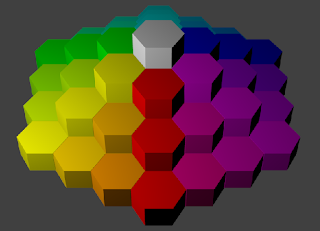Surprisingly, such a structure always contains a cubic number of hexagonal tiles (aka hexes). The structure above is 4 high and contains 4 x 4 x 4 = 64 hexes.
In a previous blog post, I gave an algebraic proof of why this must be so. Now I present a visual demonstration to help you really understand why!
In a way, what I'm trying to show is this...
Let's look at the pyramid of hexagons from almost directly above. See how each hex has an equivalent block in the cube...
But what about the hidden pieces in the pyramid and cube - do they also correspond directly?
Yes, they do. The visible pieces of each structure form a "shell" over that structure. Remove these shells and you are left with a smaller pyramid and cube. The outer shells of these smaller structures map across in exactly the same way. Keep on peeling away the layers and you see that every hex tile maps to a unique block in the cube and vice versa.
I set up a spreadsheet to show how this nesting works...
And that, my friends, is how beautiful Mathematics can be!




1 comment:
See this page on hexnet.org for an alternate explanation and visualization.
Post a Comment